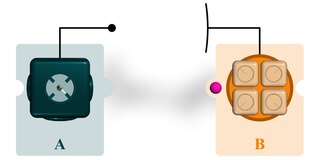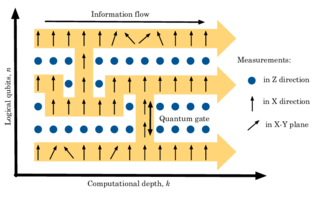
Quantum teleportation is a technique for transferring quantum information from a sender at one location to a receiver some distance away. While teleportation is commonly portrayed in science fiction as a means to transfer physical objects from one location to the next, quantum teleportation only transfers quantum information. The sender does not have to know the particular quantum state being transferred. Moreover, the location of the recipient can be unknown, but to complete the quantum teleportation, classical information needs to be sent from sender to receiver. Because classical information needs to be sent, quantum teleportation cannot occur faster than the speed of light.
In quantum computing and specifically the quantum circuit model of computation, a quantum logic gate is a basic quantum circuit operating on a small number of qubits. Quantum logic gates are the building blocks of quantum circuits, like classical logic gates are for conventional digital circuits.
Quantum error correction (QEC) is used in quantum computing to protect quantum information from errors due to decoherence and other quantum noise. Quantum error correction is theorised as essential to achieve fault tolerant quantum computing that can reduce the effects of noise on stored quantum information, faulty quantum gates, faulty quantum preparation, and faulty measurements. This would allow algorithms of greater circuit depth.
The Clifford group encompasses a set of quantum operations that map the set of n-fold Pauli group products into itself. It is most famously studied for its use in quantum error correction.

In quantum information theory, superdense coding is a quantum communication protocol to communicate a number of classical bits of information by only transmitting a smaller number of qubits, under the assumption of sender and receiver pre-sharing an entangled resource. In its simplest form, the protocol involves two parties, often referred to as Alice and Bob in this context, which share a pair of maximally entangled qubits, and allows Alice to transmit two bits to Bob by sending only one qubit. This protocol was first proposed by Charles H. Bennett and Stephen Wiesner in 1970 and experimentally actualized in 1996 by Klaus Mattle, Harald Weinfurter, Paul G. Kwiat and Anton Zeilinger using entangled photon pairs. Superdense coding can be thought of as the opposite of quantum teleportation, in which one transfers one qubit from Alice to Bob by communicating two classical bits, as long as Alice and Bob have a pre-shared Bell pair.

In computer science, the controlled NOT gate, controlled-X gate, controlled-bit-flip gate, Feynman gate or controlled Pauli-X is a quantum logic gate that is an essential component in the construction of a gate-based quantum computer. It can be used to entangle and disentangle Bell states. Any quantum circuit can be simulated to an arbitrary degree of accuracy using a combination of CNOT gates and single qubit rotations. The gate is sometimes named after Richard Feynman who developed an early notation for quantum gate diagrams in 1986.
In quantum computing, a graph state is a special type of multi-qubit state that can be represented by a graph. Each qubit is represented by a vertex of the graph, and there is an edge between every interacting pair of qubits. In particular, they are a convenient way of representing certain types of entangled states.
In quantum computing and quantum communication, a stabilizer code is a class of quantum codes for performing quantum error correction. The toric code, and surface codes more generally, are types of stabilizer codes considered very important for the practical realization of quantum information processing.
In mathematics and physics, in particular quantum information, the term generalized Pauli matrices refers to families of matrices which generalize the properties of the Pauli matrices. Here, a few classes of such matrices are summarized.

The one-way or measurement-based quantum computer (MBQC) is a method of quantum computing that first prepares an entangled resource state, usually a cluster state or graph state, then performs single qubit measurements on it. It is "one-way" because the resource state is destroyed by the measurements.
In quantum information and quantum computing, a cluster state is a type of highly entangled state of multiple qubits. Cluster states are generated in lattices of qubits with Ising type interactions. A cluster C is a connected subset of a d-dimensional lattice, and a cluster state is a pure state of the qubits located on C. They are different from other types of entangled states such as GHZ states or W states in that it is more difficult to eliminate quantum entanglement in the case of cluster states. Another way of thinking of cluster states is as a particular instance of graph states, where the underlying graph is a connected subset of a d-dimensional lattice. Cluster states are especially useful in the context of the one-way quantum computer. For a comprehensible introduction to the topic see.
A decoherence-free subspace (DFS) is a subspace of a quantum system's Hilbert space that is invariant to non-unitary dynamics. Alternatively stated, they are a small section of the system Hilbert space where the system is decoupled from the environment and thus its evolution is completely unitary. DFSs can also be characterized as a special class of quantum error correcting codes. In this representation they are passive error-preventing codes since these subspaces are encoded with information that (possibly) won't require any active stabilization methods. These subspaces prevent destructive environmental interactions by isolating quantum information. As such, they are an important subject in quantum computing, where (coherent) control of quantum systems is the desired goal. Decoherence creates problems in this regard by causing loss of coherence between the quantum states of a system and therefore the decay of their interference terms, thus leading to loss of information from the (open) quantum system to the surrounding environment. Since quantum computers cannot be isolated from their environment and information can be lost, the study of DFSs is important for the implementation of quantum computers into the real world.
Entanglement distillation is the transformation of N copies of an arbitrary entangled state into some number of approximately pure Bell pairs, using only local operations and classical communication.
In the theory of quantum communication, the entanglement-assisted stabilizer formalism is a method for protecting quantum information with the help of entanglement shared between a sender and receiver before they transmit quantum data over a quantum communication channel. It extends the standard stabilizer formalism by including shared entanglement . The advantage of entanglement-assisted stabilizer codes is that the sender can exploit the error-correcting properties of an arbitrary set of Pauli operators. The sender's Pauli operators do not necessarily have to form an Abelian subgroup of the Pauli group over qubits. The sender can make clever use of her shared ebits so that the global stabilizer is Abelian and thus forms a valid quantum error-correcting code.
Quantum block codes are useful in quantum computing and in quantum communications. The encoding circuit for a large block code typically has a high complexity although those for modern codes do have lower complexity.
In quantum computing, the quantum Fourier transform (QFT) is a linear transformation on quantum bits, and is the quantum analogue of the discrete Fourier transform. The quantum Fourier transform is a part of many quantum algorithms, notably Shor's algorithm for factoring and computing the discrete logarithm, the quantum phase estimation algorithm for estimating the eigenvalues of a unitary operator, and algorithms for the hidden subgroup problem. The quantum Fourier transform was discovered by Don Coppersmith.
In quantum computing and quantum information theory, the Clifford gates are the elements of the Clifford group, a set of mathematical transformations which normalize the n-qubit Pauli group, i.e., map tensor products of Pauli matrices to tensor products of Pauli matrices through conjugation. The notion was introduced by Daniel Gottesman and is named after the mathematician William Kingdon Clifford. Quantum circuits that consist of only Clifford gates can be efficiently simulated with a classical computer due to the Gottesman–Knill theorem.
Parity measurement is a procedure in quantum information science used for error detection in quantum qubits. A parity measurement checks the equality of two qubits to return a true or false answer, which can be used to determine whether a correction needs to occur. Additional measurements can be made for a system greater than two qubits. Because parity measurement does not measure the state of singular bits but rather gets information about the whole state, it is considered an example of a joint measurement. Joint measurements do not have the consequence of destroying the original state of a qubit as normal quantum measurements do. Mathematically speaking, parity measurements are used to project a state into an eigenstate of an operator and to acquire its eigenvalue.
The five-qubit error correcting code is the smallest quantum error correcting code that can protect a logical qubit from any arbitrary single qubit error. In this code, 5 physical qubits are used to encode the logical qubit. With and being Pauli matrices and the Identity matrix, this code's generators are . Its logical operators are and . Once the logical qubit is encoded, errors on the physical qubits can be detected via stabilizer measurements. A lookup table that maps the results of the stabilizer measurements to the types and locations of the errors gives the control system of the quantum computer enough information to correct errors.





















